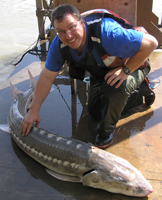AQUACULTURE STUDENT

RICHARD BUSSANICH
What They Did Back Then
* Master of Science in Aquaculture completed 1994, University of Guelph
Advisor: Professor Richard D. Moccia
Ontario Trout Quality Management: The potential for a total quality management philosophy and strategy involving the development of a quality assurance and quality control inspection system for the Ontario trout farming industry.
ABSTRACT
Ontario’s small and medium sized trout producers and processors have the potential skills and tools to provide a quality trout product. A consistent supply of high quality trout is demanded if these particular participants are to sustain a fitness to survive. This paper discusses one proposal for a program called Ontario Trout Quality Management (OTQM) which is bounded by the framework of Total Quality Management (TQM) for providing a highly consistent trout product.
The objectives provided the preliminary foundations for such a program. The first objective involved discussing the philosophy and the concept of TQM. Additionally, a potential strategy for industry participants was outlined.
The second objective involved the implementation of an industry survey. The survey demonstrated that the industry perceives the needs of the market in terms of criteria for assessing a quality trout product. However, there exists a slight difference between non-integrated and integrated producers with respect to the criteria demanded for quality value-added products such as fillets. Such a difference requires that non-integrated producers be informed of these needs. Also, the issue of specifications for pigmentation was made evident from the industry survey.
The issues and differences regarding the perception of quality trout could be resolved from the development of a quality assurance and quality control inspection system. Therefore, the third objective involved designing a QAQC inspection system for standardizing the product, procedures and materials for supplying a quality trout product.
The fourth objective involved testing the practicality of the QAQC inspection system by implementing a field trial. The system proved practically feasible since it required approximately one minute for the thorough inspection of one fish. Also, the system did not demand high level of skill for its implementation.
Results were obtained from the field study which allowed for modifications to the QAQC inspection system. One criteria involved the modification of condition factor. Condition factor was determined to be an insufficient criteria for determining a quality trout product, for trout that weighed less than 600 grams. Furthermore, the issue of pigmentation would require modification. The field study showed that the specifications for pigmentation are too demanding. It is suggested that the pigmentation colour unit be reduced from 16 to 13 for fillet products in order that improvements in accuracy and precision of pigmentation be attained.
The field study demonstrated that a few product and process attributes sowed significant results, and allowed for developing potential specifications and tolerances. The attributes included eye shape, fins, scale loss, meat cuts to the finished product, bones present in filleted products, and proper evisceration of the products.
Furthermore, the field study indicated the feasibility for a grading system with respect to size and the number of fish required for sampling as a tool of quality assessment. The grading system involved the segregation of trout weighing less than 600 grams into groups consisting of small, medium and large 1,2, and 3. A sample size of 30 fish were determined to be sufficient for providing the information needed in detecting the defects for lots consisting of less than 250 fish.
The industry survey, the development of a QAQC inspection system, and the field trial are the preliminary stages for establishing an Ontario Trout Quality Management program. The industry needs to make a commitment to quality, and OTQM provides that avenue for a consistently high quality trout product.
Where They Are Now
Following completion of his Masters Degree, Richard has committed over a decade to researching and managing Pacific salmon fisheries, focusing on protocol development for assessing fish populations and habitat, utilizing advanced hydroacoustic technology. In addition, Richard has managed numerous biotelemetry and mark-recapture studies on large Canadian rivers. His research interests lie with First Nations co-management and common property fisheries including; stock assessments, integrated fish-water uses, fish health enhancement strategies and overall system design, with particular attention to salmonids.
Richard’s current work as a technical advisor of the acclaimed international Nisga’a Fisheries Program makes him responsible for transferring knowledge and applicable skills to members of the Nisga’a First Nation in monitoring salmon escapement, fisheries harvest and various research factors known to limit production of salmon and non-salmon species in the Nisga’a territory. He is also co-manager of the third largest sockeye fishery in Canada. Unable to appease his passion for field work, Richard is also involved in salmon conservation and restoration initiatives in the Fraser River Basin.